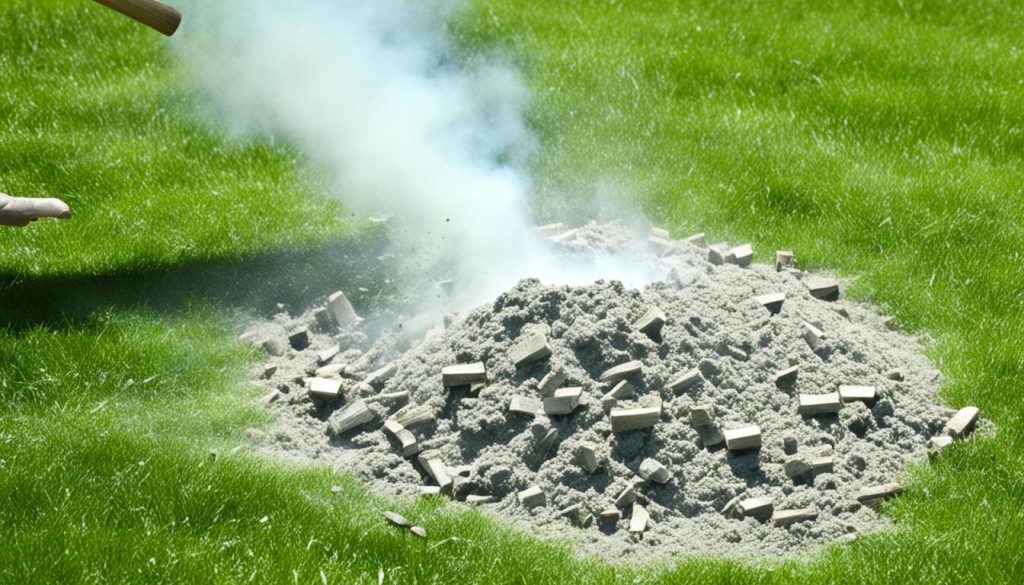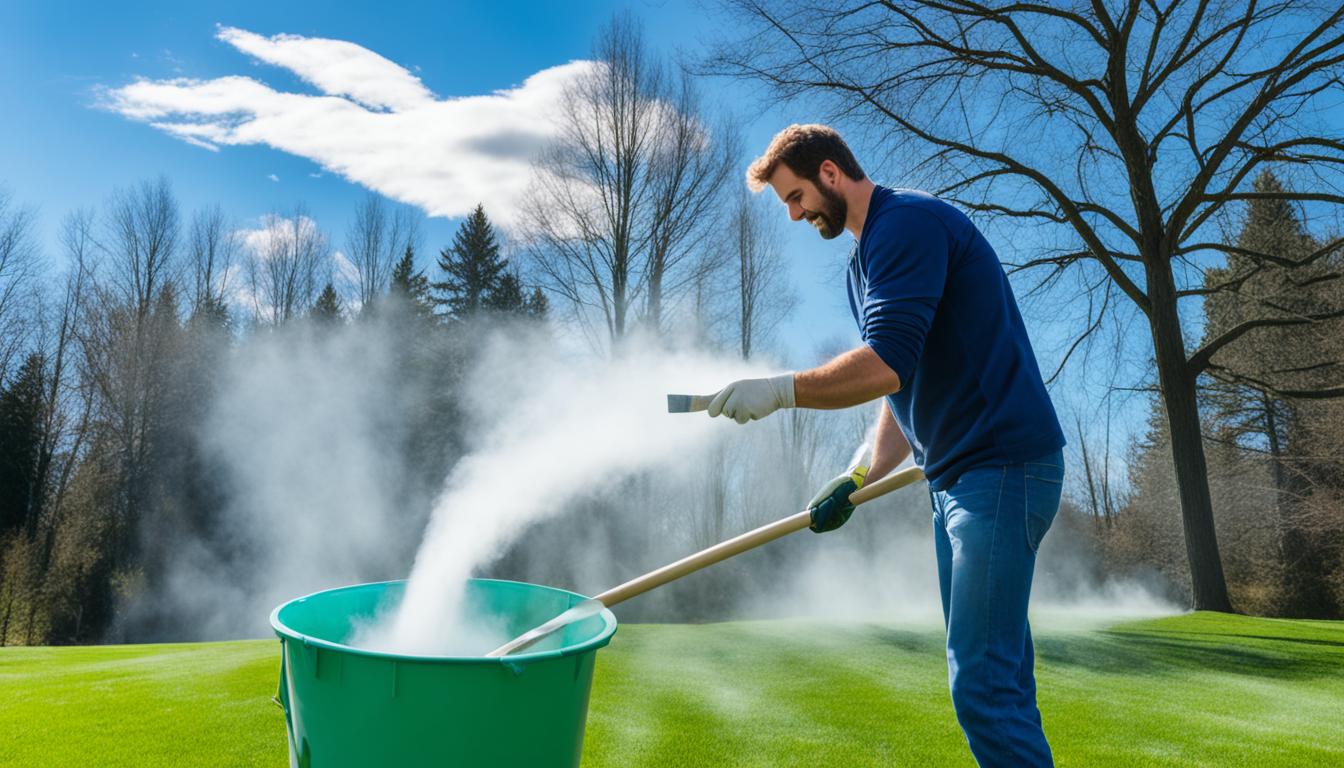Are you looking for a natural and cost-effective way to fertilize your lawn? Have you ever considered using wood ash? You may be surprised to learn that wood ash can provide several benefits to your lawn when used correctly. But how exactly should you spread wood ash on your lawn to ensure optimal results?
In this article, we’ll explore the best practices for incorporating wood ash into your lawn care routine. We’ll discuss the potential benefits of using wood ash on your lawn, how to apply it properly, and important precautions to consider. By the end, you’ll have all the knowledge you need to effectively use wood ash as a natural fertilizer for your lawn.
Key Takeaways:
- Wood ash can be used as a natural lawn fertilizer, but it should not be relied upon as the sole source of nutrients.
- Wood ash contains potassium, which can benefit root growth and promote healthier grass.
- It is important to conduct a soil test and measure the correct amount of wood ash to avoid overcorrecting pH levels.
- Excessive applications of wood ash can result in an imbalanced pH and an overabundance of salts, harming your lawn.
- Wood ash can also be used for other purposes such as composting and pest control.
Is Wood Ash Good for Your Lawn?
Wood ash can have positive effects on your lawn if used properly. It contains micronutrients and potassium, both of which can benefit the soil and promote healthy grass growth.
However, it is important to note that wood ash should not be applied to lawns that already have a high pH or are rich in potassium. Additionally, the alkalinity of wood ash can be detrimental to acid-loving plants, such as blueberries and azaleas.
It is crucial to assess your lawn’s specific needs and conduct a soil test before applying wood ash.
| Benefits of Wood Ash on Lawn | Considerations for Using Wood Ash |
|---|---|
|
|
Benefits of Wood Ash on Lawn
- Provides micronutrients
- Supplies potassium for healthy root growth
- Improves soil quality
Considerations for Using Wood Ash
- Avoid applying to high pH lawns
- Not suitable for potassium-rich lawns
- May harm acid-loving plants
How to Apply Wood Ash to Your Lawn
When it comes to applying wood ash to your lawn, following proper guidelines and best practices is crucial to achieve optimal results. By taking the necessary steps, you can ensure that your lawn benefits from the nutrients and improvements wood ash provides. Follow the tips below to effectively apply wood ash on your grass.
1. Conduct a Soil Test
Before applying wood ash, it’s essential to understand the specific needs of your lawn. Conduct a soil test to determine the pH levels and existing nutrient content in your soil. This valuable information will help you determine if wood ash is necessary and how much to apply.
2. Spread Evenly with an Applicator
When applying wood ash, it’s important to spread it evenly across your lawn. Use an applicator, such as a bucket, to ensure consistent distribution. This will prevent over-application or concentration of wood ash in certain spots.
3. Avoid Direct Contact with Green or Acid-Loving Plants
When applying wood ash, make sure to avoid direct contact with green or acid-loving plants. Wood ash is alkaline in nature and can be detrimental to these plants. Focus on spreading the wood ash evenly over the lawn, keeping it away from any existing plants.
4. Adjust the Amount based on Soil Type and Specific Needs
The amount of wood ash needed for your lawn will vary based on soil type and its specific needs. Sandy soils may require less wood ash, while clay soils may benefit from a slightly higher application rate. Consider the recommendations from your soil test and adjust the amount accordingly.

Benefits of Using Wood Ash on Your Lawn
Incorporating wood ash into your lawn care routine can provide several benefits. It can help improve soil quality by neutralizing pH levels and providing additional potassium to support plant growth. Wood ash contains essential nutrients that promote root development, leading to a healthier and more resilient lawn.
Here are some key benefits of using wood ash on your lawn:
- Soil Quality Improvement: Wood ash can help balance the pH levels of acidic soil by increasing alkalinity. This is especially beneficial for lawns that have acidic soil, as it creates a more neutral environment for grass to thrive.
- Potassium Enrichment: Wood ash is a rich source of potassium, an essential nutrient for plant growth. Potassium promotes root health, improves drought tolerance, and enhances overall plant vigor.
- Enhanced Nutrient Absorption: The presence of wood ash in the soil can improve the availability and uptake of other essential nutrients, such as nitrogen and phosphorus. This promotes healthy grass growth and vibrant green color.
- Disease Resistance: The alkaline nature of wood ash can help deter certain lawn diseases and pests. It creates an environment that is less favorable for fungal pathogens and harmful insects.
To further illustrate the benefits of using wood ash on your lawn, consider the following table:
| Benefit | Description |
|---|---|
| Soil Quality Improvement | Neutralizes soil pH and provides a more favorable environment for grass growth. |
| Potassium Enrichment | Supplies essential potassium for root development and overall plant health. |
| Enhanced Nutrient Absorption | Improves the availability and uptake of other nutrients, promoting healthy grass growth. |
| Disease Resistance | Creates an environment that is less conducive to lawn diseases and harmful insects. |
By incorporating wood ash into your lawn care routine, you can promote overall soil health and achieve a lush, vibrant lawn. However, it is important to use wood ash in moderation and in conjunction with proper soil testing to avoid any potential risks or imbalances.
Precautions and Considerations for Using Wood Ash on Your Lawn
While spreading wood ash on your lawn can have benefits, it is important to exercise caution and follow best practices to ensure optimal results and prevent any potential harm to your grass. Here are some key precautions and considerations to keep in mind:
1. Avoid Excessive Applications
Applying excessive amounts of wood ash can lead to an imbalanced pH level and an excess of salts in the soil. This can be detrimental to the health of your grass and other plants. It is crucial to apply wood ash in moderation and follow the recommended application rates specific to your soil type.
2. Test Soil pH Before Application
Prior to spreading wood ash on your lawn, it is important to conduct a soil test to determine the pH level. If your soil already has high pH levels, applying wood ash can further raise the alkalinity and lead to unfavorable growing conditions for your grass. Only use wood ash when it is necessary to correct the pH level of your soil.
3. Avoid Acid-Loving Plants
Wood ash is alkaline in nature, which can be harmful to acid-loving plants such as blueberries and azaleas. If you have such plants in your lawn, it is recommended to avoid using wood ash in their proximity to prevent any negative effects on their growth and health.
4. Conduct Proper Soil Testing
Conducting regular soil testing will help you understand the nutrient composition and pH level of your lawn. This information will guide you in determining the appropriate amount of wood ash to apply and ensure that it is used effectively without causing harm to your grass.
5. Apply Evenly and Avoid Direct Contact
When spreading wood ash on your lawn, ensure that it is applied evenly to avoid concentrated spots that can potentially damage the grass. Use an applicator or a bucket to disperse the ash evenly across the entire lawn. Additionally, avoid direct contact of wood ash with green plants to prevent any burning or damage.
By following these precautions and considerations, you can safely incorporate wood ash into your lawn care routine and reap the benefits it offers. Remember that wood ash should be used judiciously and in tandem with other lawn care practices to maintain a healthy and vibrant lawn.
Recommended Wood Ash Application Rates Based on Soil pH
| Soil pH Range | Recommended Wood Ash Application (lbs/1,000 sq ft) |
|---|---|
| 5.5-6.4 | 10-15 |
| 6.5-7.4 | 5-10 |
| 7.5-8.4 | 2-5 |
Note: These are general recommendations. It is essential to consider your specific soil conditions and consult with a lawn care professional for accurate guidance on wood ash application rates.
Other Uses for Wood Ash
In addition to its benefits in lawn care, wood ash can serve various purposes in and around your home. Here are some alternative uses for wood ash:
1. Enhancing Compost
Wood ash can be a valuable addition to your compost pile. Adding small amounts of wood ash to your compost helps improve its quality by providing essential nutrients such as potassium. The alkaline nature of wood ash can also help neutralize acidic compost, creating a more balanced environment for beneficial microorganisms and enhancing decomposition.
2. Pest Repellent
The scent of wood ash can act as a natural pest repellent. Sprinkling a thin layer of wood ash around plants and garden beds can deter insects and bugs, helping to protect your crops and flowers. The abrasive texture of wood ash can also discourage slugs and snails from crawling over it, providing an effective barrier against these garden pests.
3. Stain Removal
Wood ash can be used as a non-toxic and eco-friendly stain remover for asphalt and concrete surfaces. Water mixed with wood ash creates a mildly abrasive paste that can help remove stubborn stains, such as grease or oil spills, from driveways, walkways, and patios. Gently scrubbing the stain with the ash paste and rinsing it off can restore the cleanliness and appearance of the surface.

Remember, when using wood ash for these alternative purposes, it’s important to exercise moderation and consider the specific needs of each application. Too much wood ash can have adverse effects, so use it sparingly and always follow best practices. With its versatile uses, wood ash proves to be a valuable resource beyond just lawn care.
Choosing the Right Wood Ash
When it comes to using wood ash as a lawn fertilizer, the quality of the ash is crucial. Different types of wood produce varying amounts of available potassium and salts in the ash, which can affect its effectiveness on your grass. It’s important to collect wood ash from a suitable source to ensure its cleanliness and purity.
To maximize the benefits of wood ash on your lawn, avoid using ash from fires that burned treated or painted wood. These types of wood can contain harmful chemicals that may be detrimental to your grass. Instead, opt for wood ash from natural, untreated wood sources.
Why Clean and Properly Collected Wood Ash Matters
Clean and properly collected wood ash ensures that you’re using a high-quality product that will benefit your lawn. Ash contaminated with chemicals can introduce toxins to the soil, potentially harming your grass and other plants. By using clean and pure wood ash, you can confidently incorporate it into your lawn care routine, knowing that you’re providing your grass with the best possible nutrients.
Benefits of Choosing the Right Wood Ash
Choosing the right wood ash for your lawn fertilization needs can lead to several benefits. Clean and pure ash will contain higher levels of available potassium, which promotes root growth and overall plant health. It also helps in neutralizing pH levels in the soil, creating an optimal environment for your grass to thrive.
When using wood ash as a lawn fertilizer, ensure that you’re making a wise choice by selecting high-quality ash from natural wood sources. Your grass will thank you for it.
Potential Risks of Using Wood Ash on Your Lawn
While incorporating wood ash into your lawn care routine can have numerous benefits, it is important to be aware of the potential risks associated with its use. Spreading wood ash on your lawn without proper precautions can lead to adverse effects on the grass and other plants in your yard.
Imbalanced pH Levels
An excessive application of wood ash can disrupt the pH balance of your soil, which can harm the grass and other plants. Wood ash has a high alkaline content, and when applied in large quantities, it can raise the pH level to an unfavorable level for grass growth. It is crucial to conduct a soil test and follow recommended application rates to avoid imbalanced pH levels on your lawn.
Alkalinity and Salt Content
Wood ash contains high levels of alkalinity and salt, which can be damaging if applied improperly. Excessive amounts of wood ash can increase the alkalinity in the soil, making it less conducive to healthy grass growth. Additionally, the salt content in wood ash can accumulate over time and harm plants by dehydrating them. To prevent these risks, it is important to carefully consider the amount of wood ash you apply and follow recommended guidelines.
Insufficient Nitrogen Content
Wood ash primarily consists of potassium and does not provide significant nitrogen content, which is an essential nutrient for plant growth. Using wood ash as the sole source of fertilizer can result in a nitrogen deficiency in your lawn, leading to stunted growth and yellowing grass. It is important to supplement wood ash with a nitrogen-rich fertilizer or organic amendments to ensure your lawn receives all the necessary nutrients.
| Risks of Using Wood Ash on Your Lawn | Preventive Measures |
|---|---|
| Imbalanced pH levels | – Conduct soil tests – Follow recommended application rates |
| Alkalinity and salt content | – Apply wood ash in moderation – Consider the salt sensitivity of plants |
| Insufficient nitrogen content | – Supplement with nitrogen-rich fertilizer – Use wood ash as a supplement, not the sole source of nutrients |
By being aware of these potential risks and taking the necessary preventive measures, you can safely incorporate wood ash into your lawn care routine while maximizing its benefits. Following recommended guidelines and conducting regular soil tests will help ensure that your lawn thrives with the appropriate use of wood ash.
Conclusion
Using wood ash on your lawn can be a beneficial addition to your lawn care routine, provided it is used correctly. Wood ash can improve the quality of the soil, promote root growth, and provide essential nutrients for your grass. However, it is crucial to exercise caution and follow recommended practices to avoid potential risks.
Before applying wood ash, it is important to conduct a soil test to determine if your soil actually requires it and to measure the correct amount. Spreading the wood ash evenly using an applicator, such as a bucket, and avoiding direct contact with green plants or acid-loving plants is essential. Excessive applications of wood ash can lead to imbalanced pH levels and cause harm to your lawn.
By incorporating wood ash into your lawn care routine in a safe and controlled manner, you can enhance the health and appearance of your grass over time. Remember to always follow best practices, conduct soil tests, and avoid excessive applications to ensure the safe and effective use of wood ash as a natural lawn fertilizer. Enjoy the benefits of wood ash by nurturing your lawn and promoting a vibrant, thriving outdoor space.





